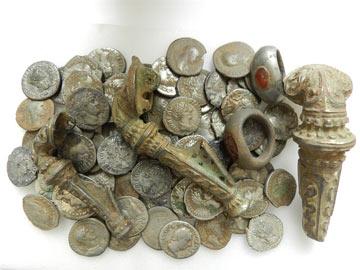Roman treasures of Cheshire

First public display in Liverpool
Two exciting new finds of Roman treasure go on public display for the first time at the Museum of Liverpool from 13 February to 19 June 2016
Roman Treasures of Cheshirepresents the Cheshire Hoards; the collective name of the two remarkable groups of Roman artefacts, discovered in recent years by local metal detectorists.
The treasure hoards, which were probably buried for safekeeping, give us an extraordinary insight into Roman life:
- The Knutsford Hoard found in 2012 by detectorist, Alan Bates includes jewellery items, notably three fine examples of gilt 'trumpet’ brooches, so named after their open circular ends. These objects were sometimes associated with the Roman army. The Knutsford Hoard also includes two finger rings, made from cast silver with decorative stone settings, possibly used as a letter sealers. They are small enough to belong to a woman or may have been worn on the lower knuckle of a man's hand. More than 100 coins which were issued between 32BC to the late 2nd century AD also feature.
- The Malpas Hoard, found in 2014 during a metal detecting rally, was probably buried in the mid-1st century AD, and comprises 35 Iron Age and Roman coins. Intriguingly, the hoard contains a mixture of coins from two areas which is very unusual. Iron Age coins include those marked EISV, usually found in the west around Gloucestershire, as well as those marked VEP CORF, generally from the east, near Lincolnshire and Leicestershire.
Liz Stewart, Curator of Archaeology and the Historic Environment at the Museum of Liverpool said:
“These two hoards provide fascinating evidence about the wealth, trade, lifestyles and identities of people in the North West in the early Roman period. It’s very special to be able to acquire and display these items for the region and to explore the long history of the area with our visitors.”
The Cheshire Hoards were reported to archaeologists through the Portable Antiquities Scheme and declared treasure. They were acquired in partnership between the Museum of Liverpool and Congleton Museum to be preserved and displayed to the public of the North West with a generous grant from the Heritage Lottery Fund.
Ian Doughty, Collections Manager at Congleton Museum said,
“The hoards tell the story of the early history of the region, and point to links between the Cheshire salt fields and the coastal trading centres in and around Merseyside. We’re delighted that with Heritage Lottery Fund support, visitors to our museums can learn more about the region’s history.”
Sara Hilton, Head of Heritage Lottery Fund, North West said:
“It’s fantastic to see these two important hoards on display to the public for the first time. They reveal so much about the way our ancestors lived and how the community around here developed into what it is today. I hope that everyone takes this opportunity to delve into and get inspired by this history”
To celebrate the first public display of the Cheshire Hoards the Museum of Liverpool is hosting a free public conference on 27 February 2015 from 10am to 5pm.
The Cheshire Hoards and the Romano-British North West brings together expert-speakers from across the UK. Discussions will centre on the two hoards and delve into greater detail on their context and how they contribute to our understanding of life in North West England through the 1st and 2nd centuries AD.
www.liverpoolmuseums.org.uk/cheshirehoards
#cheshirehoards
Notes to Editors
Museum of Liverpool
The Museum of Liverpool is one of the country’s most visited museums outside of London. It is the largest newly-built national museum in Britain for more than a century, demonstrating Liverpool’s unique contribution to the world. The first national museum devoted to the history of a regional city, it showcases popular culture while tackling social, historical and contemporary issues. It has attracted more than two million visitors since opening in July 2011. The prestigious Council of Europe Museum Prize for 2013 was awarded to the Museum for its commitment to human rights as well as its work with children and families from all backgrounds.
The Museum has received generous support from several major funders, and grants from trusts and foundations, corporate support and individual donations. Major funders include the Northwest Regional Development Agency (NWDA), The European Regional Development Fund (ERDF), the Heritage Lottery Fund (HLF), the Department for Culture Media and Sport (DCMS),Garfield Weston Foundation and the Clore Duffield Foundation.
The Northwest Regional Development Agency (NWDA) was responsible for the sustainable economic development and regeneration of England’s Northwest and had five key priorities: Business, Skills and Education, People and Jobs, Infrastructure and Quality of Life.
The European Development Fund (ERDF) is making a real difference to people and businesses in the North West. With €755 million to invest between 2007 and 2013, ERDF is enhancing the competitiveness of the region’s economy by supporting growth in enterprise and employment. ERDF in the North West is managed by the Department for Communities and Local Government.
Using money raised through the National Lottery, the Heritage Lottery Fund (HLF) sustains and transforms a wide range of heritage for present and future generations to take part in, learn from and enjoy. From museums, parks and historic places to archaeology, natural environment and cultural traditions, we invest in every part of our diverse heritage. HLF has supported more than 30,000 projects allocating £4.5billion across the UK. www.hlf.org.uk
About National Museums Liverpool
National Museums Liverpool comprises eight venues, including some of the most visited museums in England outside of London. Our collections are among the most important and varied in Europe and contain everything from Impressionist paintings and rare beetles to a lifejacket from the Titanic. We attract nearly 2.7 million visitors every year. Our venues are the Museum of Liverpool, World Museum, the Walker Art Gallery, Merseyside Maritime Museum, International Slavery Museum, Border Force National Museum, Sudley House and the Lady Lever Art Gallery.
